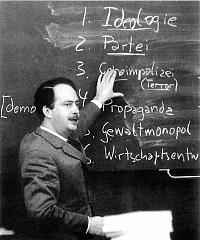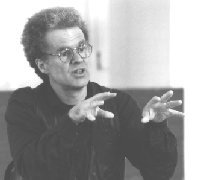|
Links |
|
Links |
|
| - Project: ICAs, & Class Analysis |
|
||
|
|
- Biography & Major Works | ||
| THE COMBINATION OF FUNCTIONALISM & CONFLICT THEORY EXAMINES SOCIETAL NORMAL OPERATIONS, & SOCIAL CHANGE | |||
| Dahrendorf integrated Marxism & structural functionalism | |||
| Dahrendorf operates at the same, macro, level as structural functionalists & looks at many of the same issues of stability, functions, etc. | |||
| Dahrendorf theorized that on the one hand some parts of society fit together well & function smoothly while on the other hand, other parts of society experience considerable conflict | |||
| Ritzer believes that Dahrendorf's theory suffers from a lack of Marxism | |||
|
|
Dahrendorf's Chart on the Continuum from Structural - Functionalism to Conflict Theory shows that many of the most important differences btwn structural functionalism & conflict theory actually represent poles on the end of a continuum, rather than different realities | ||
|
|
Society exists btwn these two poles & may even have two simultaneous faces: consensus & conflict | ||
| Consensus is an illusion
Society is held together by authority Legitimacy/authority is precarious |
|||
| DAHRENDORF FOLLOWS MARX ON THE POWER OF GRP INTERESTS BUT DIVERGES ON ECON INTERESTS, HOLDING THAT MULTI CLASS SOCIETAL GRPS DEVELOP OTHER COMMON INTERESTS | |||
| Dahrendorf interprets Marx through structural functionalism | |||
| The criticisms of structural functionalism that are addressed by Dahrendorf's theory are that it ignores change & upheaval & is too conservative | |||
| Dahrendorf accepts Marx's ideas on
- the two class theory where Dahrendorf calls the two classes the superordinate & the subordinate classes - organized ( or manifest ) group interests such as the labor movement - & unorganized ( or latent ) group interests such as conservative workers |
|
||
|
|
Dahrendorf differs from Marx is his beliefs that: |
|
|
| 1. The revolution will NOT end class conflict. There will always be conflict | |||
| 2. Class conflict in advanced industrial society is NOT based primarily or only on economic interests | |||
| 3. The upper class no longer owns & controls the means of production | |||
| 4. Dahrendorf accepts the managerial control thesis that control is divorced from ownership w/ non owning managers controlling the economy | |||
| 5. The growth of the middle class in industrial societies has altered the nature of the economic divisions as described by Marx | |||
| 6. Conflict theory ignores order & stability; it's too radical | |||
| 7. For most Marxism & conflict theory, conflict emerges, unexplained, from structural functional like systems | |||
| INTERESTS ARE NOT BASED ONLY ON CLASS, BUT ON LIFESTYLE AS WELL | |||
|
|
Dahrendorf is similar to Marx on his belief that interests are not psychological, but structurally generated by defined positions |
|
|
|
|
Taking Marx's understanding of interests, Dahrendorf combines it w/ the structural functionalist's understanding of manifest & latent functions |
|
|
|
|
Manifest interests are conscious / intended interests and
Latent interests are unconscious / unintended interests |
|
|
|
|
Dahrendorf's examination of manifest & latent interests is similar to, but an expansion of, Marx's concept of class consciousness |
|
|
|
|
Interest groups are groups in support of latent/manifest interests
Conflict groups are interest groups that are engaged in conflict |
|
|
| Social change occurs when conflict groups form | |||
| Dahrendorf is similar to Weber in his beliefs on authority | |||
| - Authority resides in positions not individual thus one may have authority in one sphere but not another | |||
| - Legitimate authority has sanctions to back it up | |||
|
|
Dahrendorf accepts Weber's position that power struggles in modern society occur inside bureaucracies, & not as direct conflict btwn classes |
|
|
| IMPERATIVELY COORDINATED ASSOC (ICAs) ARE BASED ON PEOPLE'S COMMON INTEREST IN AN ISSUE OF IMPORTANCE TO THEM | |||
| Class conflict will occur in imperatively coordinated associations ( ICAs ) | |||
|
|
ICAs include any association of people that is controlled by a hierarchy, thus an ICA is composed of dichotomous interest groups |
|
|
|
|
ICAs are like bureaucratic organizations centered around the major tasks/ structures in society i.e. economic or businesses, religion, politics, family, etc. |
|
|
| Conflict will be spread among various power groups w/in organizations & among interest groups in society | |||
| ICAs come in all sizes & examples of ICAs in the social structures
include:
1. Peers fraternities, sororities, a network of friend, NGOs, social mvmts, etc. 2. Family tribal, extended, nuclear/traditional, single parent, grandparent, etc. 3. Religion church, mosque, synagogue, temple, a high church official or a simple member 4. Work executive or consumer or worker or watch dog group 5. Govt political elite or just a citizen 6. Military family support grps, citizen honor guards, welcome committees 7. Charity support grps, public interest grps, watch dog grps 8. Ed university president or student 9. Media watch dog grps, citizen watch grps 10. Leisure / Rec informal rec grps, rec assoc |
|||
|
|
ICAs are so pervasive in society, that individual & group interests are structured by the individual or group relationships to these associations such as personal connections, org to org connections; org to network connections, network to network connections |
|
|
| W/in all ICAs there are authority roles of domination & subordination | |||
| On ICAs, Dahrendorf said, "One of the central theses of this study consists in the assumption that this differential distribution of authority invariably becomes the determining factor of systematic social conflicts of a type that is germane to class conflicts in the traditional (Marxist) sense of this term." | |||
| Unlike Marx, Dahrendorf recognized all kinds of individual or group interests |
|
||
| Dahrendorf recognized all kinds of individual or group interests related
to
- material rewards - freedom - status recognition - leisure - all kinds of services from each other - any kind of interest that develops inside an ICA |
|||
| ICAs ARE BASED ON COMMON LIFESTYLE INTERESTS, BUT CLASS / ECON INTERESTS STILL PLAY A ROLE | |||
| The key is that the means to attaining interests are related to authority positions in ICAs |
|
||
| The haves get what they want while the have nots do not get what they want & so they tend to challenge the status quo | |||
| A critique of Dahrendorf is that while he is examining org behavior, organizational analysis, org conflict, org development, etc. is not examined | |||
|
|
Individuals take positions in many ICAs at the same time |
|
|
| Each position in an ICA represents a different set of interests in relation to the authority or lack of authority held | |||
| An ICA's interests are latent until they become recognized & acted upon at which time they may become manifest to the actors | |||
| Each of the social structures may be seen as being made up of ICAs
each of which acts upon it's latent & manifest interests
1. Peers 2. Family 3. Religion 4. Work 5. Govt 6. Military 7. Charity 8. Ed 9. Media 10. Leisure / Rec |
|
||
|
|
Critiques of Dahrendorf |
|
|
|
|
a. ICA conflict is much different than class conflict & therefore Dahrendorf loses the primacy of the economic base of conflict |
|
|
| In Dahrendorf's defense, he believes that the dominate ICAs in most societies are the economy & religion | |||
|
|
b. It is not clear where the middle class fits in the two class system of superordinate & subordinate classes |
|
|
| Dahrendorf says the location of the middle class depends on the particular interests of that ICA member, but this makes his analysis very complicated, but the world is complicated! | |||
|
|
c. ICAs obviously must be seen in a hierarchy of importance / influence in society but Dahrendorf gives no logic for comparing them |
|
|
|
|
However, other analysts & Dahrendorf have noted that most nations today are dominated by economic, religious, & political ICAs, indicating that these are the most influential ICAs today |

Ralf Dahrendorf 1929 - He was born in Hamburg, the son of Lina Dahrendorf and the late Gustav Dahrendorf a social democrat member of the German Parliament. He studied philosophy, classical philology and sociology in Hamburg University between 1947 and 1952, became a doctor of philosophy and classics (Dr. phil.) in 1952. He continued his academic research at London School of Economics as a Leverhulme Research Scholar 1953-54, gaining a PhD in 1956. He was a professor of sociology in Hamburg (1957-60), Tübingen (1960-64) and Konstanz (1966-69). From 1969 to 1970 he was a member of the German parliament for the Freie Demokratische Partei (Free Democratic Party), the German liberals, and a Parliamentary Secretary of State in the Ministry of Foreign Affairs. In 1970 he became a Commissioner in the European Commission in Brussels. From 1974 to 1984 he was director of the London School of Economics, when he returned to Germany to become Professor of Social Science, Konstanz University (1984-86). He settled in the United Kingdom in 1986, becoming a Governor of the London School of Economics, and also (from 1987 to 1997) Warden of St Anthony's College at Oxford University. Having adopted British citizenship in 1988, in 1993 Dahrendorf was granted a life peerage and was created Baron Dahrendorf of Clare Market in the City of Westminster by Queen Elizabeth II. He sits in the House of Lords as a crossbencher. |
 |
||||
Class & Class Conflict in Industrial Society. 1959. Stanford, CA: Stanford University Press. Europe's Economy in Crisis. 1982. Society and Democracy in Germany. 1993. Reflections on the Revolutions in Europe. 2004.
|
|||||
|
|||||
| This chart shows that many of the most important differences btwn S - F & Conflict Theory actually represent poles on the end of a continuum, rather than different realities | |||||
| Structural Functionalism | Conflict Theory | ||||
| 1. Equilibrium | 1. Continual change | ||||
| 2. All elements contribute to stability | 2. All elements contribute to conflict/change | ||||
| 3. Common morality | 3. False consciousness / imposed morality | ||||
| 4. Order | 4. Coercion / dominance | ||||

